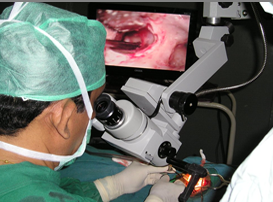Micro ear surgery, also known as microscopic otologic surgery, is a specialized field within
otolaryngology (ear, nose, and throat medicine) that focuses on the precise treatment of
various ear disorders using advanced microsurgical techniques. This delicate procedure
involves the use of a high-powered operating microscope and miniature instruments to access
and repair intricate structures within the ear. Let's delve into the intricacies of micro
ear surgery and explore its advancements.
-
Precision Instruments:
- Micro ear surgery relies on cutting-edge instruments designed specifically for
intricate ear procedures.
- These instruments are incredibly small and delicate, allowing surgeons to work
within the confined spaces of the ear canal with utmost precision.
- Examples of micro ear surgery instruments include microscopes, microhooks,
microforceps, and microdrills.
-
Conditions Treated:
- Micro ear surgery is employed to treat a wide range of ear disorders, including:
- Chronic otitis media (middle ear infection)
- Cholesteatoma (a benign growth in the middle ear)
- Conductive hearing loss due to ear bone abnormalities
- Inner ear disorders such as Meniere's disease
- Acoustic neuroma (a benign tumor of the vestibulocochlear nerve)
- Congenital abnormalities of the ear
-
Advantages of Micro Ear Surgery:
- Enhanced Visualization: The use of high-powered microscopes provides
unparalleled visualization of the intricate structures within the ear, enabling
surgeons to perform precise maneuvers.
- Minimally Invasive: Micro ear surgery techniques are minimally invasive,
resulting in smaller incisions, reduced trauma to surrounding tissues, and
faster recovery times for patients.
- Improved Outcomes: The precise nature of micro ear surgery often leads to
improved treatment outcomes, including better preservation of hearing function
and reduced risk of complications.
-
Surgical Techniques:
- Tympanoplasty: Repair of the eardrum to restore hearing and prevent recurrent
infections.
- Mastoidectomy: Removal of infected mastoid air cells to treat chronic otitis
media or cholesteatoma.
- Stapedectomy: Removal of the stapes bone and insertion of a prosthetic device to
treat conductive hearing loss.
- Cochlear Implantation: Surgical placement of a device to bypass damaged hair
cells in the cochlea, restoring hearing in patients with severe to profound
sensorineural hearing loss.
-
Future Directions:
- Continued Advancements in Technology: With ongoing technological innovations,
the field of micro ear surgery is poised to further improve surgical outcomes
and expand the range of treatable conditions.
- Personalized Medicine: Tailoring treatment approaches based on individual
patient characteristics, such as anatomy and genetics, may lead to more
personalized and effective interventions.
- Collaborative Research: Collaboration between surgeons, engineers, and
researchers will drive the development of novel techniques and technologies in
micro ear surgery.
